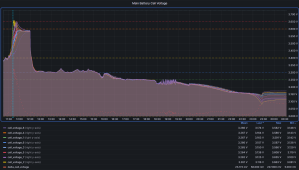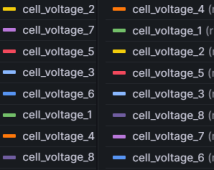So I have 8 new cells. I intend to parallel them with the existing 8. Some of that 8 are lower capacity and some higher, maybe a few Ah! It would be wise to pair the lower cells with their higher counterpart.
So I did this to the new cells.

The peak charge was initially assisted by the charger, but completed by the solar. Discharge was "real loads" and real cut off voltage.
By zooming in on that I can get an ordered list of cell voltages, at their visibly widest point ... both at top of charge and at bottom.
Example. Cell 6 is "fecked" on the existing 8. It's always early up and first down. On the new pack, even above you might see that Cell 2 was first over and first under. The reverse pairs come out just as quickly. i have months of data for the existing 8, so I now have my cell pairings

So I did this to the new cells.

The peak charge was initially assisted by the charger, but completed by the solar. Discharge was "real loads" and real cut off voltage.
By zooming in on that I can get an ordered list of cell voltages, at their visibly widest point ... both at top of charge and at bottom.
Example. Cell 6 is "fecked" on the existing 8. It's always early up and first down. On the new pack, even above you might see that Cell 2 was first over and first under. The reverse pairs come out just as quickly. i have months of data for the existing 8, so I now have my cell pairings



